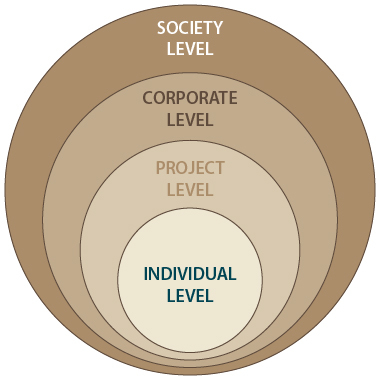The sustainability concept
Fundamental :
Sustainability is one of the most important challenges of our time and the immediate future. This concept tries to give an answer to the following issue:
How can we develop prosperity, without compromising the life of future generations?
Fundamental :
It is for that reason that ‘sustainability' will find it's way to project management methodologies and practices in the very near future.
Why ?
Fundamental :
The issue of sustainability is drawn by the research of "the satisfaction of human needs and aspirations in the major objective of development. The essential needs of vast numbers of people in developing countries for food, clothing, shelter, jobs - are not being met, and beyond their basic needs these people have legitimate aspirations for an improved quality of life. A world in which poverty and inequity are endemic will always be prone to ecological and other crises. Sustainable development requires meeting the basic needs of all and extending to all the opportunity to satisfy their aspirations for a better life"
(United Nations, 1987, Our Common Future, Chapter 2: Towards Sustainable Development)
To achieve sustainable development, different levels of intervention have to be considered because sustainability must be integrated in a large vision (society level) and in a specific vision (individual level). The Corporate and Project level must be an intermediate level between society and individual level.

Sustainability ?
Definition :
In order to precise the concept of sustainability, the two following quotes can be adopted:
World Commission on Environment and Development: "forms of progresses that meet the needs of the present without compromising the ability of future generations to meet their needs."
(United Nations, 1987, Our Common Future, Chapter 2: Towards Sustainable Development)
International Institute for Sustainable Development: "Adopting business strategies and activities that meet the needs of the enterprise and its stakeholders today while protecting, sustaining and enhancing the human and natural resources that will be needed in the future."
(William R. R. Blackburn, 2007, The Sustainability Handbook: The Complete Management Guide to Achieving Social, Economic and Environmental Responsibility, Earthcan, USA)
Fundamental :
To go further concerning the sustainability concept, it is recognized that he world must be seen as a system that connect space and a system that connect time:
So, the sustainability concept contains within it two issues:
The issue of NEEDS, in particular the essential needs of the world's poor, to which priority should be given,
The idea of LIMITATION imposed by the state of technology and social organization on the environment's ability to meet present and future needs.
Example :
A system that connect space :
Air pollution or pesticides sprayed from a country affects air quality of the world.
A system that connect time :
A decision taken by us today will have an impact on our children's future.
Example 1: The sixth continent:
"There is a patch of floating garbage in the North Pacific. It is twice the size of Texas. It is so large; it has been dubbed the 6th Continent. It is not a pretty sight and it is killing the ocean. One of the major causes is people drinking water from plastic bottles. In the US alone, 173 589 041 plastic bottles are dumped in the oceans every day."
Example 2: Chernobyl Nuclear Accident
"The Chernobyl accident is the most serious accident in the history of the nuclear industry. Indeed, the explosion that occurred on 26 April 1986 in one of the reactors of the nuclear power plant, and the consequent fires that lasted for 10 days, led to huge amounts of radioactive materials being released into the environment and a radioactive cloud spreading over much of Europe. The greatest contamination occurred around the reactor in areas that are now part of Belarus, Russia, and Ukraine. Since the accident, some 600 000 people have been involved in emergency, containment, cleaning, and recovery operations, although only few of them have been exposed to dangerous levels of radiation. Those who received the highest doses of radiation were the emergency workers and personnel that were on-site during the first days of the accident (approximately 1000 people)."
"At present, more than five million people live in areas that are considered to be ‘contaminated' with radioactive materials from the Chernobyl accident 1. The area closest to the reactor site was most heavily contaminated and the 116 000 people who lived there were evacuated soon after the accident."






